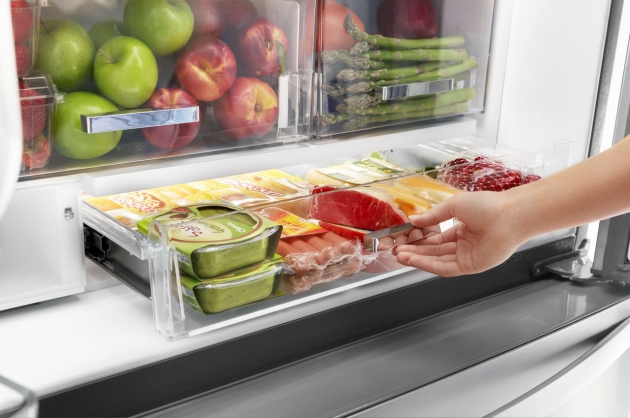A bold claim? Possibly, but let’s face it, most people don’t have much control over the contents of their refrigerators. The contents may lurch from full to empty with no middle ground until shopping day arrives and the full space is not utilized properly. Proper airflow must be maintained with a space of ½” between food items to prevent cross contamination. But this can be tricky to achieve when you’re managing a busy refrigerator. In this article, we will look at one simple hack that may help.
Refrigerator Food Storage Basics
The optimal temperature for a refrigerator is 35-38ºF, and the areas should be split into zones to improve storage. All raw meat and dairy food items should be restricted to the lower shelves to prevent cross-contamination. Prepared foods, fruits, and vegetables should be stored on upper shelves which have minor temperature variations. The door shelves should be used to store foods that have a virtually unlimited shelf life and that need to be cold, including cans of soda, condiments, sauces, pickle jars, and more. But, there is one hack that can make these storage rules even more efficient.
Using Storage Bins in the Refrigerator
There may be dedicated storage bins built into the refrigerator that are designed for fruits or vegetables, or other food items. These should be used, but there is an opportunity to use storage bins to store items neatly on the other shelves. These are the same storage bins that many people use to store food in a pantry, and they work equally well in the refrigerator.
This is an underused and misunderstood refrigerator hack that is easy to get wrong. The basic rules of refrigerator food storage still apply, but on those shelves, the food items can be placed in storage bins. Specific categories can be created for each bin, and they can be labeled clearly for easy identification. It’s even possible to create an inventory for each storage bin to avoid food spoilage and to lower the food bills. As an example: a kid’s snack bin will prevent the kids from disrupting other areas in the refrigerator.
The secret sauce in this hack is that storage bins are stackable, and this can help you to take full advantage of your refrigerator space. Going vertical will improve access in the same way that many use storage bins in their pantries. There are various storage bin sizes and shapes that you can purchase to customize the storage options in your refrigerator. These bins will prevent spills and drips that can spread bacteria to other food items on a shelf. The storage bin is easier to clean quickly; simply remove the items, clean the bin, replace the items and you’re done. A spray bottle filled with a bleach solution in a ratio of one tablespoon of unscented bleach to a gallon of water is an effective disinfectant.
The only real drawback is that the storage bins will need regular cleaning at the same time as the shelves. It’s recommended that a deep refrigerator cleaning occurs every three months to maintain and promote cleanliness. An open container of baking soda can make the spaces fresher, but this should be replaced during the deep cleaning. Double-walled shelves should not be submerged in water to prevent the trapping of water in between the glass walls. Trapped water is an ideal growth medium for mold, which will degrade the health and cleanliness of the refrigerator.
If you’re considering a new refrigerator or freezer, you can explore your options through our online collection or for further guidance, speak to a home appliance specialist.

